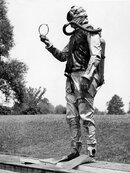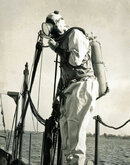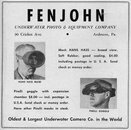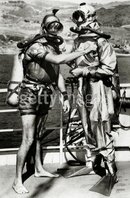Thanks for the images of the early model La Spirotechnique Constant Volume suits. I dove one of the late-model black vulcanized suits… no surprise it never proved very popular. Hanes Keller and Peter Small used this suit on the record setting 1000' bounce dive off Catalina in the 1960s. I am not sure if he used it on earlier deep dives, but probably did since there was no other product readily available.
I never realized the early models were made from such an unusual material. Does anyone have a clue what it was? This post prompted me to look at photos in Cousteau’s The Silent World, and there is a B&W image of this early suit.
This is the father of modern drysuits. I don’t recall any real progress in drysuit design for Scuba divers until the Poseidon Unisuit came out in the mid-late 1960s. As you can tell from the images, the Constant Volume suit didn’t have a neck seal or a separate inflation valve. You filled the suit to prevent squeeze by letting air leak past your lips or blowing out your nose to overpressure the maks cavity. It was really dangerous in Scuba because your only option if you ran out of air was to pull the faceplate off and breathe thru your nose. Since the face seal on the mask is designed for external pressure, you could easily fill the suit with water if you allowed your head to go more than a few inches underwater.
My one experience was especially bad because I was too short for the suit and the hood tended to lift off unless I cinched the neck strap down too tight for comfort. Talk about a claustrophobia machine!








